
Diese Seite auf deutsch 
The distance to the Moon
(You will find last informations below and on a preparation page.)
The project day is over. Please, look at our results in our data page and view some impressions of our partners. Some additional tips had been published shortly before the project day.
k.jpg)
The first submitted picture (Erwin Polreich, Breitenfurt near Wien)
Goal of this project
When you drive a car during the night and see the moon at the sky the moon will, as all stars, go along with you perfectly: It seems to be infinitely far away.
It is the goal of this project to visualize and to mediate the experience that the distance to the moon is not infinitely large. We will determine this distance by taking photographs simultaneously from different locations all over the world and by comparing the moon's positions on these pictures.
Therefore, the moon should be photographed within the constellation Leo
on May 30th/31th, 2009, 12.00, 17.00, 20.00, 22.00 and 02.00 UT
(possible alternative: October 10th/11th, 2009, 19.00, 02.00, 4.00, 08.00 and 19.00 UT)
from as many locations on earth as possible so that, at least, Regulus and Saturn can be made out, additionally.
By comparison of the resulting pictures, it will become obvious that the moon's position with respect to the background of stars depends on the position of observation. The following picture shows a corresponding simulation.
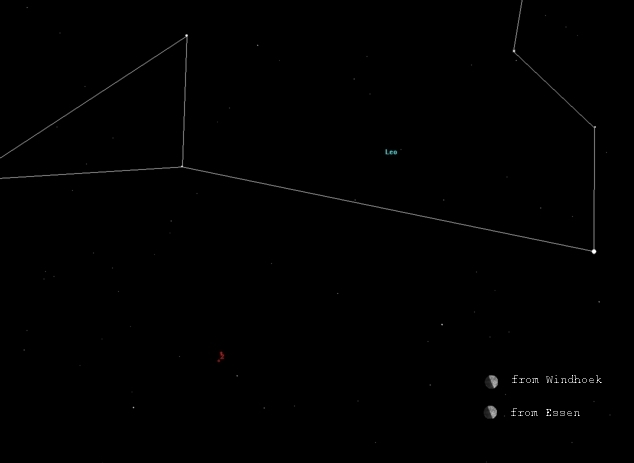
Moon, simultaneously photographed from Essen (Germany) and Windhoek (Namibia) on May 30th, 2009, 21.00 UT
(simulated with Guide 8.0)
Selection of the observation time
The moon seems to be much brighter than stars and planets. Therefore, it is quite difficult to make pictures showing not only the moon but some bright stars and/or planets. Either the moon is suitable exposured, then the exposure time is too short for imaging other objects. Or bright stars and planets are clearly to recognize, then the moon's image is by far to bright.
This problem may be solved by two actions:
- Pictures of the moon are made when bright stars and/or planets are in the near neighbourhood. The brightest stars passed by the moon during one month are Aldebaran (α Tau), Castor and Pollux (α und β Gem), Regulus (α Leo) and Antares (α Sco). But, in order to be able to measure the moon's position at least two reference objects are needed. Therefore, most often a bright planet nearby is necessary. In 2009, Saturn close to Regulus and Mars near Castor and Pollux may be suitable.
- Pictures of the moon are made when it is illuminated to a small part only (as waxing or waning crescent). But, the "younger" the moon is the shorter it is visible at night, or vice versa, the smaler the part of the earth's night side which is visible to the moon. The narrower the crescent the less people can observe the moon simultaneously! Therefore, a compromise must be found between the moon's brightness as small as possible and a simultaneous visibility from an as large part of the earth's night side as possible.
In 2009, there will be no proper situation with the moon between two bright planets. However, at the proposed time the waxing half moon is between Saturn and Regulus. It can be observed during the first half of the night. At the alternative observation time the moon will stand near Castor, Pollux and Mars. But as waning half moon, it must be observed in the second half of the night. And to do that would be much less convenient!
Observing times and participating countries
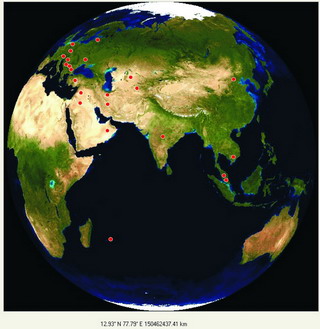
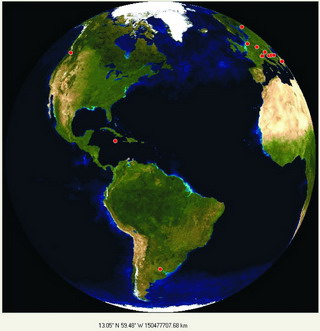
The locations of our actual participants
This map and the corresponding table will be actualized continuously.
May 30th, 2009, 20.00 UT (22.00 MESZ) will be the central observing time of this project. At that moment the moon will be visible from Europe (without the British Islands and Scandinavia) and from Africa. In order to give as many people as possible the opportunity to participate we propose additional observing times. The following tabular and the picture below visualize which countries can take part at which times:
| Time | Participating countries |
| May 30th, 10.00 UT |
East Asia, Indonesia and Australia |
| May 30th, 17.00 UT |
South and East Africa, Arabia, India, East Russia |
| May 30th, 20.00 UT |
Africa, Turkey, Europe without British Islands and Scandinavia |
| May 30th, 22.00 UT |
North, West und South Europe, West Africa, large parts of South America |
May 31th, 02.00 UT
May 30th, 22.00 EDT! |
eastern parts of the USA, Central America and large parts of South America |

The earth as seen from the moon at the proposed observing times. (simulated with Home Planet 3.3a)
The pictures visualize in which countries the moon will be observable at night.
Observing procedure
- We asked all people interessed in participating to send their email address (it will not be published!) and their geographical position. We will mark their positions in the world maps above showing all locations from which the moon will be photographed.
- Use the maximum magnification of your zoom objective. Of course, the moon and the reference objects must be contained in the picture. (On project day, the angular distance between Saturn and Regulus will be about 15°.There the equivalent focal length must be smaler than 135mm.)
- Let T0 be the proposed moment of observation.
Take three photos with exposure times -2, -1,±0, +1, +2 every time
- at T0 - 15 min
- at T0 and
- at T0 + 15 min.
Perhaps, it will be clever to take two pictures directly successive, one of them with exposure time suitable for the moon, the other with longer exposure time for the reference objects, and to superpose both pictures later. (Example picture, K. Völkel, Bamberg)
- Measure the pixel coordinates of Saturn, Regulus and moon on the digitized pictures by yourself (for instance, with the program evalmoonpicts).
-
Put your picture, your name and location and the self-determined pixel coordinates into our datapage. Additional pictures, comments and experience reports may be sent to
 .
.
- The results will be automatically published as tabulars. These results will enable every participant to combine the own results with suitable ones of other observers living far away in order to get an own measure of the distance to the moon.
- All of the measured moon's positions will be put into a reference picture. We hope to get a dense cloud of points!
- Perhaps, a simplified procedure will be offered enabling the participants themselves to determine the moon's distance to the earth "by hands".
- We offer the program calcmoonsparallax for combining arbitrary measures and calculating the resulting moon's distance. The used algorithm (only in German, up to now) will be published and explained.
Preparation on May, 3rd, 2009
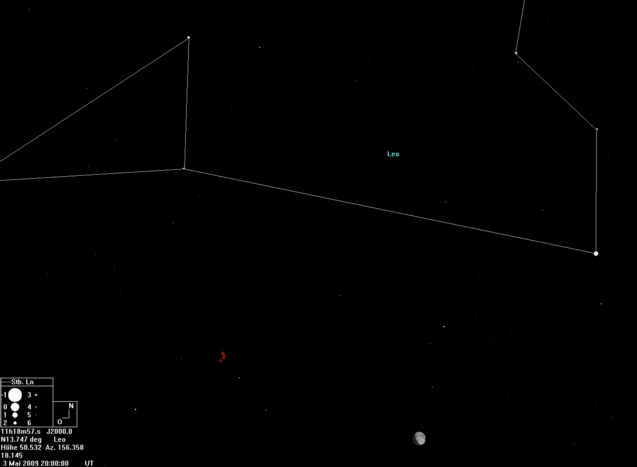
On May, 3rd, the moon's position close to Regulus and Saturn was very similar to that on May, 30th. But the moon was about 8.6 days old. Therefore, it was more than half illuminated. A suitable exposure time was to be found more difficultly than on May, 30th. But, exposure times found on May, 3rd, will be suitable on May, 30th, too! Unfortunately, the weather in Europe was hardly suitable on that day and only few pictures have been taken.
The results and experiences of this preparation date have been published for all participants.
Possible alternative project date: Oktober, 11th, 2009, 4.00 UT
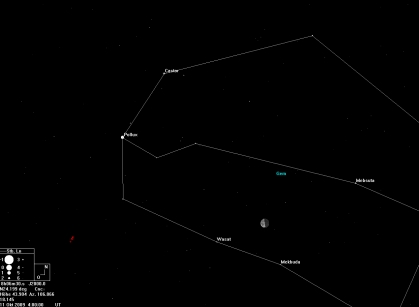 |
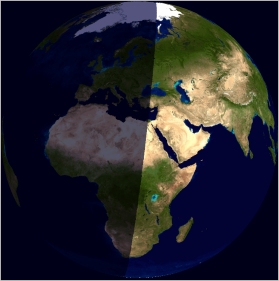 |
| Moon within the constellation Twins |
The earth, seen from the moon |
A project very similar to that proposed here has been performed, some years ago.

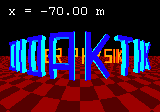
 Udo Backhaus
Udo Backhaus

last change: last update: 2020-03-06


k.jpg)




 .
.




 Udo Backhaus
Udo Backhaus
